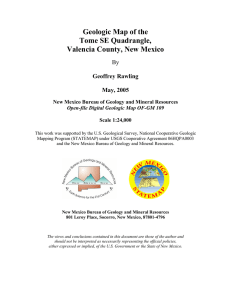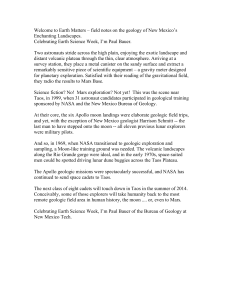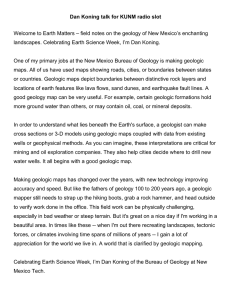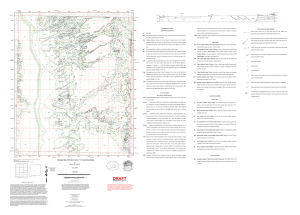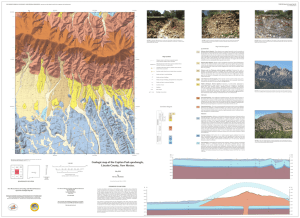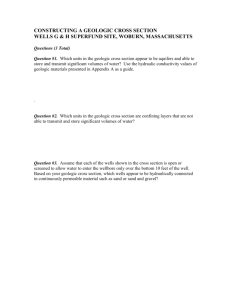Document 11032432
advertisement
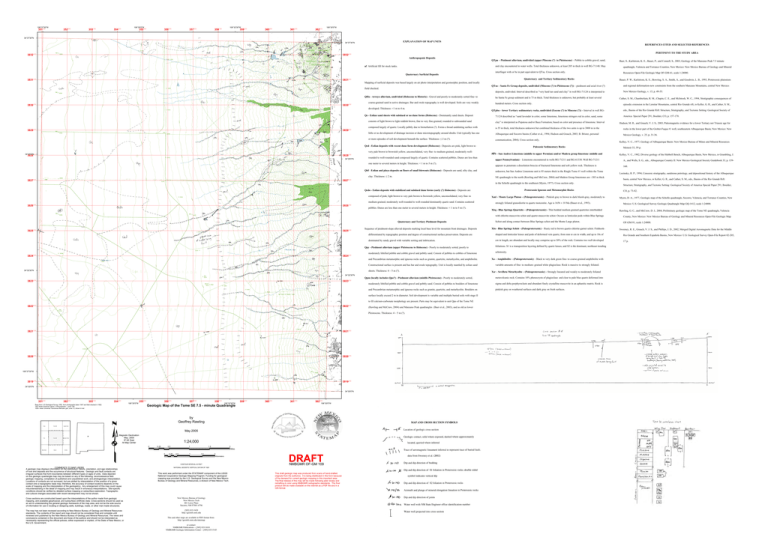
106°37'30"W 351000 352000 353000 354000 106°35'0"W 355000 356000 357000 106°32'30"W 358000 359000 360000 361000 362000 106°30'0"W 34°37'30"N EXPLANATION OF MAP UNITS 34°37'30"N 3832000 REFERENCES CITED AND SELECTED REFERENCES PERTINENT TO THE STUDY AREA 3832000 Anthropogenic Deposits af Artificial fill for stock tanks. QTpu – Piedmont alluvium, undivided (upper Pliocene (?) to Pleistocene) – Pebble to cobble gravel, sand, and clay encountered in water wells. Total thickness unknown, at least 205 m thick in well RG-71148. May quadrangle, Valencia and Torrance Counties, New Mexico: New Mexico Bureau of Geology and Mineral interfinger with or be in part equivalent to QTsu. Cross section only. Resources Open-File Geologic Map OF-GM-61, scale 1:24000. Quaternary Surficial Deposits 3831000 3831000 Baer, S., Karlstrom, K. E., Bauer, P., and Connell, S., 2003, Geology of the Manzano Peak 7.5 minute Quaternary and Tertiary Sedimentary Rocks Bauer, P. W., Karlstrom, K. E., Bowring, S. A., Smith, A., and Goodwin, L. B., 1993, Proterozoic plutonism Mapping of surficial deposits was based largely on air photo interpretation and geomorphic position, and locally QTsu – Santa Fe Group deposits, undivided (Miocene (?) to Pleistocene (?)) – piedmont and axial river (?) and regional deformation-new constraints from the southern Manzano Mountains, central New Mexico: field checked. deposits, undivided. Interval described as “very hard tan sand and clay” in well RG-71124 is interpreted to QHa - Arroyo alluvium, undivided (Holocene to Historic) - Gravel and poorly to moderately sorted fine- to 3830000 3830000 coarse-grained sand in active drainages. Bar and swale topography is well developed. Soils are very weakly developed. Thickness: <1 m to 4 m. Qe - Eolian sand sheets with subdued or no dune forms (Holocene) - Dominantly sand sheets. Deposit 3829000 3829000 be Santa Fe group sediment and is 73 m thick. Total thickness is unknown, but probably at least several hundred meters. Cross section only. 71124 described as “sand lavender in color, some limestone, limestone stringers red in color, sand, some 3828 34°35'0"N composed largely of quartz. Locally pebbly due to bioturbation (?). Forms a broad undulating surface with is 55 m thick, total thickness unknown but combined thickness of the two units is up to 3000 m in the rocks in the lower part of the Grober-Fuqua #1 well, southeastern Albuquerque Basin, New Mexico: New little or no development of drainage incision or dune microtopography around shrubs. Unit typically has one Albuquerque and Socorro basins (Cather et al., 1994; Hudson and Grauch, 2003; B. Brister, personal Mexico Geology, v. 25, p. 31-36. or more episodes of soil development beneath the surface. Thickness: ≤ 2 m (?). communication, 2004). Cross section only. rounded to well-rounded sand composed largely of quartz. Contains scattered pebbles. Dunes are less than Qbf - Eolian and playa deposits on floors of small blowouts (Holocene) - Deposits are sand, silty clay, and clay. Thickness: ≤ 2 m. Paleozoic Sedimentary Rocks P&l – San Andres Limestone (middle to upper Permian) and/or Madera group limestone (middle and medium-grained, moderately well-rounded to well-rounded dominantly quartz sand. Contains scattered pebbles. Dunes are less than one meter to several meters in height. Thickness: < 1 m to 5 m (?). Quaternary and Tertiary Piedmont Deposits 3825000 3825000 Sequence of piedmont-slope alluvial deposits marking local base level for mountain front drainages. Deposits 3824000 34°32'30"N 160. unknown, but San Andres Limestone unit is 95 meters thick in the Ringle Tome #1 well within the Tome Proterozoic Igneous and Metamorphic Rocks Xml – Monte Largo Pluton – (Paleoproterozoic) – Pinkish gray to brown to dark bluish-gray, moderately to strongly foliated granodiorite to quartz monzonite. Age is 1656 ± 10 Ma (Bauer et al., 1993). Xbq - Blue Springs Quartzite – (Paleoproterozoic) - Thin bedded medium grained quartzites interbedded 3820000 3820000 106°37'30"W 3819000 3819000 34°30'0"N 34°30'0"N 351000 352000 353000 354000 Base from U.S.Geological Survey 1952, from photographs taken 1947 and field checked in 1952. 1927 North American datum, UTM projection -- zone 13N 1000- meter Universal Transverse Mercator grid, zone 13, shown in red 106°35'0"W 355000 356000 357000 358000 106°32'30"W Geologic Map of the Tome SE 7.5 - minute Quadrangle 359000 360000 361000 362000 106°30'0"W by Geoffrey Rawling Tome Tome NE Capilla Peak May 2005 Turn Tome SE Manzano Peak Magnetic Declination May, 2005 9º 54' East At Map Center 1:24,000 0 Black Butte Becker 0.25 0.5 1 1.5 2 Scholle 0 0.25 0.5 1 1.5 2 Kilometers CONTOUR INTERVAL 20 FEET COMMENTS TO MAP USERS A geologic map displays information on the distribution, nature, orientation, and age relationships of rock and deposits and the occurrence of structural features. Geologic and fault contacts are irregular surfaces that form boundaries between different types or ages of units. Data depicted on this geologic quadrangle map may be based on any of the following: reconnaissance field geologic mapping, compilation of published and unpublished work, and photogeologic interpretation. Locations of contacts are not surveyed, but are plotted by interpretation of the position of a given contact onto a topographic base map; therefore, the accuracy of contact locations depends on the scale of mapping and the interpretation of the geologist(s). Any enlargement of this map could cause misunderstanding in the detail of mapping and may result in erroneous interpretations. Site-specific conditions should be verified by detailed surface mapping or subsurface exploration. Topographic and cultural changes associated with recent development may not be shown. Miles DRAFT NMBGMR OF-GM 109 NATIONAL GEODETIC VERTICAL DATUM OF 1929 This work was performed under the STATEMAP component of the USGS National Cooperative Geologic Mapping Program. Funding for geological mapping was provided by the U.S. Geological Survey and the New Mexico Bureau of Geology and Mineral Resources, a division of New Mexico Tech. Cross sections are constructed based upon the interpretations of the author made from geologic mapping, and available geophysical, and subsurface (drillhole) data. Cross-sections should be used as an aid to understanding the general geologic framework of the map area, and not be the sole source of information for use in locating or designing wells, buildings, roads, or other man-made structures. New Mexico Bureau of Geology New Mexico Tech 801 Leroy Place Socorro, NM 87801-4796 The map has not been reviewed according to New Mexico Bureau of Geology and Mineral Resources standards. The contents of the report and map should not be considered final and complete until reviewed and published by the New Mexico Bureau of Geology and Mineral Resources. The views and conclusions contained in this document are those of the authors and should not be interpreted as necessarily representing the official policies, either expressed or implied, of the State of New Mexico, or the U.S. Government. [505] 835-5420 http://geoinfo.nmt.edu This and other maps are available in PDF format from: http://geoinfo.nmt.edu/statemap or contact: NMBGMR Publications -- [505] 835-5410 NMBGMR Geologic Information Center -- [505] 835-5145 This draft geologic map was produced from scans of hand-drafted originals from the author(s). It is being distributed in this form because of the demand for current geologic mapping in this important area. The final release of this map will be made following peer review and redrafting in color using NMBGMR cartographic standards. The final product will be made available on the internet as a PDF file and in a GIS format. Mexico: U.S. Geological Survey Geologic Quadrangle Map GQ-1412, scale 1:24000. Rawling, G. C., and McCraw, D. J., 2004, Preliminary geologic map of the Tome NE quadrangle, Valencia County, New Mexico: New Mexico Bureau of Geology and Mineral Resources Open-File Geologic Map Schist and along contact between Blue Springs schist and the Monte Largo pluton. OF-GM-91, scale 1:24000. Xbs - Blue Springs Schist - (Paleoproterozoic) – Rusty red to brown quartz-chlorite-garnet schist. Fishhook- Sweeney, R. E., Grauch, V. J. S., and Phillips, J. D., 2002, Merged Digital Aeromagnetic Data for the Middle 17 p. moderately lithified pebble and cobble gravel and pebbly sand. Consist of pebbles to cobbles of limestone foliations. S1 is a transposition layering defined by quartz lenses, and S2 is the dominant, northeast trending schistosity. and Precambrian metamorphic and igneous rocks such as granite, quartzite, metarhyolite, and amphibolite. Xa – Amphibolite – (Paleoproterozoic) – Black to very dark green fine- to coarse-grained amphibolite with Constructional surface is present and has bar and swale topography. Unit is locally mantled by eolian sand variable amounts of fine- to medium- grained white plagioclase. Rock is massive to strongly foliated. Xsr – Sevilleta Metarhyolite – (Paleoproterozoic) – Strongly lineated and weakly to moderately foliated metavolcanic rock. Contains 10% phenocrysts of plagioclase and clear to pale blue quartz deformed into moderately lithified pebble and cobble gravel and pebbly sand. Consist of pebbles to boulders of limestone sigma and delta porphyroclasts and abundant finely crystalline muscovite in an aphanitic matrix. Rock is and Precambrian metamorphic and igneous rocks such as granite, quartzite, and metarhyolite. Boulders on pinkish gray on weathered surfaces and dark gray on fresh surfaces. (Rawling and McCraw, 2004) and Manzano Peak quadrangles (Baer et al., 2003), and as old as lower Pleistocene. Thickness: 4 – 5 m (?). 3821000 Myers, D. A., 1977, Geologic map of the Scholle quadrangle, Socorro, Valencia, and Torrance Counties, New cm in length, are abundant and locally may comprise up to 50% of the rock. Contains two well developed to III calcium-carbonate morphology are present. Parts may be equivalent to unit Qpo of the Tome NE 3821000 CO, p. 73-82. dominated by sandy gravel with variable sorting and imbrication. surface locally exceed 2 m in diameter. Soil development is variable and multiple buried soils with stage II 3822000 Structure, Stratigraphy, and Tectonic Setting: Geological Society of America Special Paper 291, Boulder, Rio Grande and Southern Española Basins, New Mexico: U.S. Geological Survey Open-File Report 02-205, Qpm (locally includes Qpo?) - Piedmont alluvium (middle Pleistocene) - Poorly to moderately sorted, 3822000 basin, central New Mexico, in Keller, G. R., and Cather, S. M., eds., Basins of the Rio Grande Rift: with chlorite-muscovite schist and quartz-muscovite schist. Occurs as lenticular pods within Blue Springs 34°32'30"N 3823000 Lozinsky, R. P., 1994, Cenozoic stratigraphy, sandstone petrology, and depositional history of the Albuquerque shaped and lenticular lenses and pods of deformed vein quartz, from mm to cm in width, and up to 10s of sheets. Thickness: 4 – 5 m (?). 3823000 Kelley, V. C., 1982, Diverse geology of the Hubbell Bench, Albuquerque Basin, New Mexico, in Grambling, J. differentiated by topographic position and degree of constructional surface preservation. Deposits are Qpy - Piedmont alluvium (upper Pleistocene to Holocene) - Poorly to moderately sorted, poorly to 3824000 Memoir 33, 59 p. appears to penetrate a dissolution breccia of fractured limestone and soft yellow rock. Thickness is Qedo - Eolian deposits with stabilized and subdued dune forms (early (?) Holocene) - Deposits are 3826000 Kelley, V. C., 1977, Geology of Albuquerque Basin: New Mexico Bureau of Mines and Mineral Resources A., and Wells, S. G., eds., Albuquerque Country II: New Mexico Geological Society Guidebook 33, p. 159- in the Scholle quadrangle to the southeast (Myers, 1977). Cross section only. composed of pink, light brown to very pale brown to brownish yellow, unconsolidated, very fine- to Hudson, M. R., and Grauch, V. J. S., 2003, Paleomagnetic evidence for a lower Tertiary not Triassic age for upper Pennsylvanian) – Limestone encountered in wells RG-71211 and RG-61338. Well RG-71211 NE quadrangle to the north (Rawling and McCraw, 2004) and Madera Group limestones are ~385 m thick 3827000 3826000 America Special Paper 291, Boulder, CO, p. 157-170. clay” is interpreted as Popatosa and/or Baca Formation, based on color and presence of limestone. Interval one meter to several meters in height. Thickness: < 1 m to 5 m (?). 3827000 eds., Basins of the Rio Grande Rift: Structure, Stratigraphy, and Tectonic Setting: Geological Society of consists of light brown to light reddish brown, fine to very fine-grained, rounded to subrounded sand very pale brown to brownish yellow, unconsolidated, very fine- to medium-grained, moderately well3828000 Cather, S. M., Chamberlain, R. M., Chapin, C. E., and McIntosh, W. C., 1994, Stratigraphic consequences of episodic extension in the Lemitar Mountains, central Rio Grande rift, in Keller, G. R., and Cather, S. M., QTpbu – lower Tertiary sedimentary rocks, undivided (Eocene (?) to Miocene (?)) – Interval in well RG- Qed - Eolian deposits with recent dune form development (Holocene) - Deposits are pink, light brown to 34°35'0"N000 New Mexico Geology, v. 15, p. 49-55.
